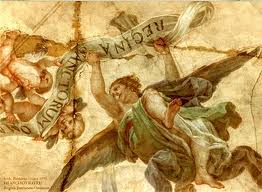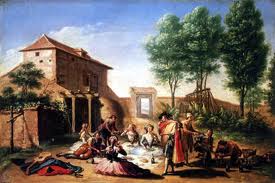Baroque: Francisco Bayeu
Francisco Bayeu y Subías was a Spanish painter who was famous for his paintings in the Romantic, Neoclassical and Baroque styles. Bayeu y Subías was also a part of a famous family of painters which included his two brothers, Ramón and Manuel.
Francisco Bayeu y Subías (1734-1795)

Little is know of Francisco Bayeu y Subías's early childhood but we do know that he was born in Zaragoza and it is therefore most likely that he began his education here either with the Jesuits or the Escolapios. At the age of fourteen, Francisco began training with the Baroque Spanish painter José Luzán Martínez until the year of 1753.
When the painter Antonio González Velázquez arrived in Zaragoza, he hired Francisco Bayeu y Subías as a helper for one of his works. The relationship between the two must have been very strong as for many years, Antonio González Velázquez financially supported the young Francisco with his studies in Madrid at the 'Real Academia de Bellas Artes de San Fernando' (Royal Academy of Fine Arts of San Fernando).
From 1753, Francisco Bayeu y Subías worked as an artist in Madrid. In 1758 he returned to Zaragoza where he was acquiring a large clientele. Here he married his wife Sebastiana Merclein y Salillas, the daughter of another local painter who was familiar with the Aragonese art market, which was in fact one of the reasons for their wedding. From this point on, Bayeu y Subías's commissions increased and his works became popular, and the most famous of this period was the piece he painted for the 'Monasterio Jerónimo de Santa Engracia de Zaragoza' (Jeronimo Monastery of Saint Grace of Zaragoza).

In 1763, Francisco Bayeu y Subías was called to come to Madrid by Anton Raphael Mengs in order to work collaboratively on the decoration of the Royal Palace. With the help of Mengs, Francisco became one of the most popular artists in Madrid. From then on, the majority of Bayeu y Subías's paintings would be for the Royal Court, and were often paintings of the Royal Family themselves. Francisco Bayeu y Subías was named an official Court painter in 1767 by the Spanish King, Charles III of Spain. While at the Court in Madrid, Francisco Bayeu y Subías met the young Francisco Goya whom he protected and helped out. Goya even married Bayeu y Subías's sister, Josefa Bayeu in 1773.
Bayeu y Subías was considered to be an excellent fresco painter and was often commissioned with the decoration of buildings. Together with Anton Raphael Mengs, Francisco painted many of the rooms in the various Royal palaces including the Palacio Real in Madrid, the Palacio de Aranjuez and the Palacio de El Pardo. During this time he also painted in many churches too such as the 'Convento de la Encarnación' (Convent of Incarnation) in Madrid, the 'Basílica del Pilar' (Basilica of Pilar) in Zaragoza, and the cloisters in the Cathedral of Toledo.

While painting the Basilica of Pilar in Zaragoza, Francisco Bayeu y Subías also employed Francisco Goya to help out as well as some of his own family. It was during this project that the two artists fell out and became rivals, as both were considered to be important artists of the Royal Court.
In recognition of Bayeu y Subías's work, he received many titles and awards. He became the Head Director of Painting at the Royal Academy of Fine Arts of San Fernando in Madrid in 1765, among other high positions in other Spanish art schools. He eventually became the director of the whole Academy in 1795. Francisco Bayeu y Subías also received many pay rises from the Royal Court in reward for his achievements.
Francisco Bayeu y Subías continued working and painting frescoes, content with his large salary from the Spanish Royal Family. However in 1795, he fell ill and did not recover, dying in the early morning of the 5th of August of the same year in Madrid.
